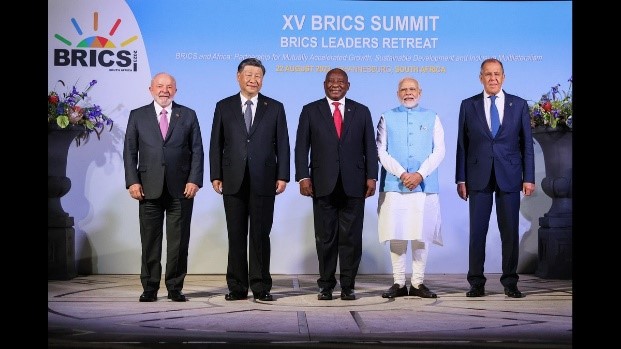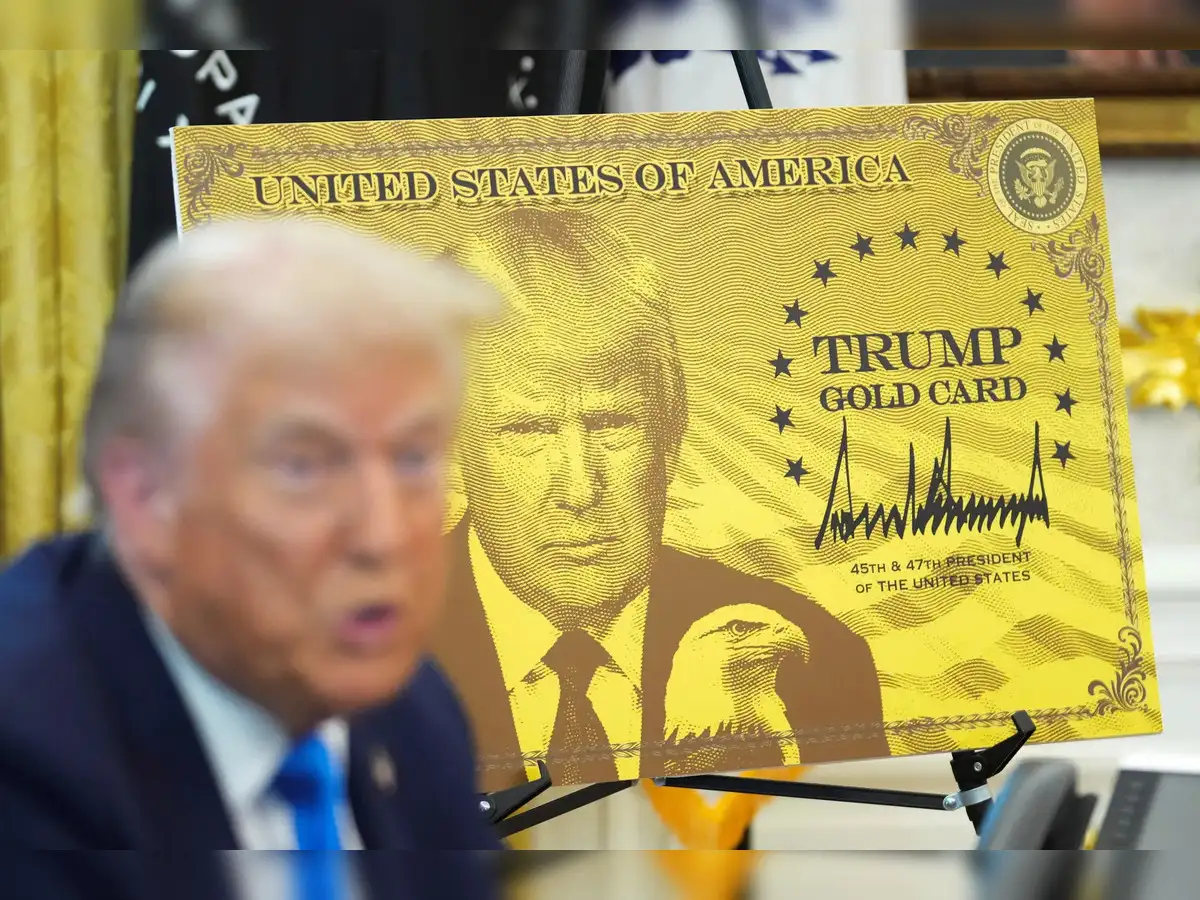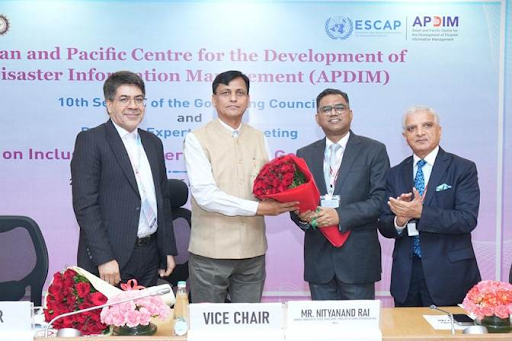Description

Disclaimer: Copyright infringement not intended.
Context
- The leaders of the BRICS nation decided to admit six countries to their grouping.
Background
- The predecessor of BRICS (Brazil, Russia, India, China, and South Africa) was BRIC (Brazil, Russia, India, and China) established by Goldman Sachs in 2006.
- BRIC was the acronym for the four countries, which were deemed to be at a similar stage of newly advanced economic development. Behind BRIC was the idea that China and India will, by 2050, be the world’s dominant suppliers of manufactured goods, while Brazil and Russia will become dominant as suppliers of raw materials.
- With the induction of South Africa in December 2010, BRIC became BRICS whose original aim was the establishment of an equitable, democratic, and multi-polar world order.
- The BRICS mechanism aims to promote peace, security, development and cooperation. It also aims at contributing significantly to the development of humanity and establishing a more equitable and fairer world.
- Despite the five members’ divergent economic trajectories in the years since—with China and India having grown impressively while the other three saw weak growth—the BRICS group has made significant progress.
- Together, BRICS countries have 3.24 billion inhabitants—or 41 percent of the world population—and a combined gross domestic product (GDP) of $26 trillion, or 60 percent of the G7 countries’ combined GDP. However, on a purchasing power parity basis, BRICS countries’ GDP accounts for 5 percent of the global economy, overtaking the G7 share of 30.4 percent. Despite this, BRICS countries get only 15 percent of the voting power at the International Monetary Fund—a source of developing countries’ discontent over the governance of international financial institutions.
- The group’s achievements include the establishment of the New Development Bank (NDB) in 2015 with a total capital of $100 billion and paid-up capital of $50 billion equally subscribed by the five members. The bank funds sustainable development and infrastructure projects in member countries; NDB-funded projects in India include the Mumbai Metro rail, the Delhi-Meerut Regional Rapid Transit System and a number of renewable energy projects.

15th BRICS Summit
- The 2023 BRICS summit is the fifteenth ongoing annual BRICS summit, an international relations conference attended by the heads of state or heads of government of the five member states: Brazil, Russia, India, China, and South Africa.
- South African President Cyril Ramaphosa also invited the leaders of 67 countries to the summit, including 53 other African Countries, Bangladesh, Bolivia, Indonesia and Iran.
- Discussions focus on spheres of political and socioeconomic coordination, in which member countries have identified business opportunities, economic complementarities, and areas of cooperation.
- As the Chair of BRICS, South Africa is focusing on the theme, ‘BRICS and Africa: Partnership for Mutually Accelerated Growth, Sustainable Development, and Inclusive Multilateralism’.
- This theme informs South Africa’s five priorities for 2023:
- Developing a partnership towards an equitable just transition,
- Including managing the risks associated with climate change;
- Transforming education and skills development for the future;
- Unlocking opportunities through the African continental free trade area;
- Strengthening post-pandemic socioeconomic recovery and the attainment of the 2030 agenda on sustainable development; and strengthening multilateralism, including reform of global governance institutions and strengthening the meaningful participation of women in peace processes.
BRICS EXPANSION
- The BRICS brings together five of the largest developing countries in the world—Brazil, Russia, India, China, and South Africa and represents 41 percent of the global population, 24 percent of the global GDP and 16 percent of the global trade.
- Several countries, including Argentina, Egypt, Indonesia, the UAE, Saudi Arabia, and others, are willing to join the bloc.
The proposition
- BRICS is considering expanding its membership, and a growing number of countries, mostly from the global South, have expressed interest in joining.
- Several countries including the United Arab Emirates, Saudi Arabia, Argentina, Iran, Egypt, Bahrain, Indonesia, and Kazakhstan had shown their willingness to join the BRICS.
- Around 40 countries had shown interest in joining BRICS out of which 23 formally applied for the membership.
- Earlier, representatives from Iran, Saudi Arabia, the United Arab Emirates, Cuba, the Democratic Republic of Congo, Comoros, Gabon, and Kazakhstan attended a meeting in Cape Town for so-called “Friends of BRICS” talks. Egypt, Argentina, Bangladesh, Guinea-Bissau, and Indonesia participated virtually.
The expansion in the recent 15th Summit
- The leaders of the BRICS nation decided to admit six countries, Argentina, Egypt, Ethiopia, Iran, Saudi Arabia and the United Arab Emirates(UAE) as full members of BRICS.
- The Chinese move to include Pakistan as a member country was turned down due to the strong opposition from India.
The decision to Expand
- The decision on the new members was agreed upon after firming up the guiding principles, criteria and procedures for the expansion process.
- BRICS foreign ministers have been tasked to further develop the BRICS partnership model and list of prospective countries (which want to join the grouping).
The Need for Expansion
- An expansion of the BRICS bloc is undergoing since countries – see one thing in common: a desire to level the global playing field. This is lacking because of the wealthy West's domination of international bodies, such as the United Nations, the International Monetary Fund or the World Bank. The list of grievances is long. Abusive trade practices. Punishing sanctions regimes. Perceived neglect of the development needs of poorer nations.
- Amid widespread dissatisfaction with the prevailing world order, the pledge of BRICS nations - currently Brazil, Russia, India, China and South Africa - to make the grouping a leading champion of the "Global South" has, found resonance.
Significance of the recent Expansion
- The "expansion and modernization" of BRICS is a message that all institutions in the world need to mold themselves according to changing times.
- India has always fully supported the expansion of the BRICS membership. India has been of the view that the addition of new members will further strengthen BRICS as an organization, and give a new impetus to all our common endeavors.
- The decision to expand the bloc will further strengthen the faith of many countries in the multipolar world order.
- This can become an example for the reform of other global institutions established in the 20th century.
- It will bring new vigor to the BRICS cooperation mechanism, further strengthening a force for world peace and development.
- Through this Summit, BRICS has embarked on a new chapter in its effort to build a world that is fair, a world that is just, a world that is also inclusive and prosperous.
Benefits of the BRICS Expansion and launching of BRICS currency
- Here are some of the benefits of the BRICS Expansion plan and launching of BRICS currency:
Increased Economic Cooperation:
- The BRICS countries are working together to increase their economic cooperation.
- This could lead to increased trade, investment, and development.
Reduced reliance on the US dollar:
- The BRICS countries are trying to reduce their reliance on the US dollar.
- This could give them more control over their own economies and reduce their vulnerability to US economic policies.
Increased influence in the Global Economy:
- The BRICS countries are working to increase their influence in the global economy. This could lead to increased trade, investment, and development for these countries.
- When we look at the broader aspect the BRICS Expansion plan and launching of a common currency are ambitious projects. However, they could have a significant impact on the global economy.
- If successful, these projects could lead to increased economic cooperation, reduced reliance on the US dollar, and increased influence for the BRICS countries in the global economy.
Benefits specific to India
Here are some ways in which India could benefit from the expansion of BRICS and the launch of a new BRICS currency:
Reduced dependence on the US dollar:
- India is currently heavily dependent on the US dollar for its foreign trade and currency reserves.
- This makes India vulnerable to fluctuations in the value of the dollar, which can have a negative impact on India's economy.
- A BRICS currency would provide India with an alternative to the dollar, which would reduce its dependence on the US and make its economy more stable.
Increased trade and investment:
- A BRICS currency would make it easier for India to trade with other BRICS countries.
- This could lead to increased trade and investment between India and other BRICS countries, which would boost India's economy.
Reduced political pressure from the US
- The US has a history of using its financial power to exert political pressure on other countries.
- For example, the US has imposed sanctions on countries that do not cooperate with its sanctions on Iran.
- A BRICS currency would reduce India's vulnerability to this type of political pressure from the US.
- Overall, the expansion of BRICS and the launch of a new BRICS currency could have a number of positive benefits for India. These benefits include reduced dependence on the US dollar, increased trade and investment, and reduced political pressure from the US.
Challenges
- BRICS aspirants Argentina and Egypt, to name just two, are also members of the infamous “Coffee Club” (United for Consensus) —opposed to India’s membership in the UNSC. They also get a lot of support from China.
|
COFFEE CLUB
Uniting for Consensus (UfC), nicknamed the Coffee Club, is a movement that developed in the 1990s in opposition to the possible expansion of permanent seats in the United Nations Security Council. Under the leadership of Italy, it aims to counter the bids for permanent seats proposed by G4 nations (Brazil, Germany, India, and Japan) and is calling for a consensus before any decision is reached on the form and size of the United Nation Security Council.
The Coffee Club includes Italy, Pakistan, South Korea, Colombia, Costa Rica, Mexico, Turkey, Canada, Spain, Argentina, Malta and San Marino which obstruct every move of the G4 members.
This club was established in 1995 and involves some 12 countries and primarily objects to one move in the UNSC reforms, the expansion.
The Coffee Club does not want any other permanent memberships; however, they want non-permanent seats in the UNSC to increase.
|
- China is looking at the potential expansion primarily through the lens of expanding its sphere of influence.
- China has been trying since 2017 to expand the group by including other countries to constitute a BRICS Plus framework. Its main motivation seems to be the transformation of BRICS into a China-centric bloc, entrap the new members with loans under its Belt and Road Initiative, exporting manufactured goods for which its markets in the West are contracting and demonstrating to the West that it is a leader of the Global South. China perceives that the economic performance of Brazil, Russia, and South Africa has deteriorated; Russia is besieged by the Ukraine war; India is getting closer to the US-led groupings; and unless the BRICS expands with the inclusion of big developing countries, its global influence will wane.
- With the SCO and BRICS, China dominates the two most prominent “alternate” groupings — neither of which includes the US.
- The BRICS is a relatively young group; there are wide disparities in size, outlook, and perceptions of its members about a multipolar world and restructuring of the global organs of power. The group has so far taken a non-confrontational stance and stayed away from the rivalry between the West and the China-Russia-Iran axis. Making the group too big would make decision-making more complicated and time-consuming.
Important Articles on UNSC: https://www.iasgyan.in/blogs/india-at-the-united-nations-security-council
https://www.iasgyan.in/daily-current-affairs/united-nations-security-council-unsc-45-18

Way Ahead
- BRICS should prioritize economic and social convergences among its member states and should focus on institution building, fostering trust, sharing knowledge, promoting trade and development, and advancing developmental finance. It is important for BRICS to remain committed to its core objectives.
- By maintaining a steadfast focus on its core goals and patiently working towards them, BRICS can strengthen its cooperation, enhance mutual understanding, and foster sustainable development within its member states and beyond.
- Further expansion should be gradual and based on how the new countries would contribute to mutual complementarities, strengthening, and long-term functioning of the group without deepening ideological and other divisions.
- India has to find creative ways of blunting Chinese strategy while opening up BRICS to countries that will ensure equitable distribution of power in the group.
- Also, further expansion of BRICS should be based on rule-based order and the forum should not leave any room for ‘economic hegemony’ and ‘anti-West agenda’.
- Further inclusion of countries into BRICS should be by consensus and before any move is made to expand BRICS, there must be a clear definition of principles and criteria for membership.
|
PRACTICE QUESTION
Q. The recent expansion and modernization of BRICS is a message that all institutions in the world need to mould themselves according to changing times and it sets an example for the reform of other global institutions established in the 20th century. Substantiate.
|
https://epaper.thehindu.com/ccidist-ws/th/th_delhi/issues/48969/OPS/GB1BLIVC3.1.png?cropFromPage=true












